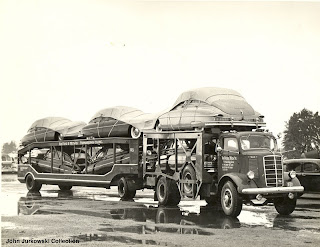
Did Oldsmobile inspire the first rock 'n' roll song? Possibly, but its Futuramic 88 was the first modern musclecar
Source: http://www.motortrend.com/classic/roadtests/c12_0612_1950_oldsmobile_88_coupe/index.html#ixzz0YnWGHbOe
Ike Turner's Fats Waller-like stride piano sets off two minutes, 51 seconds that changed music and signaled a new age of automotive power in America. The fuzz guitar, reportedly the result of a speaker damaged while Turner's Kings of Rhythm were on tour, that quickly joins in is part of the new sound. Raymond Hill's tenor sax break, taking 56 seconds, could've come from blues or jazz. It's the beat that pulls this all together into something new, although the tune owed much to rhythm and blues songs of the era. Indeed, the tune made the R&B charts-after all, there was no rock-'n'-roll Top 40 at the time, since many consider "Rocket 88" the very first song of the genre.
Click to view GalleryWhether you agree, there's no denying the impact of the opening line of "Rocket 88," sung by Jackie Brenston. One manufacturer, Oldsmobile, had successfully challenged the garage-built street primacy of the hot rod with a smooth, quick car, shiny and new and straight from the factory. The 1949 Rocket 88 came with the same high-compression (7.25:1) overhead-valve V-8 installed in the larger, heavier Ninety-Eight; thus, the Great American Musclecar was born. And it was launched with a high-compression, short-stroke power to match a postwar exuberance that had automobile styling mimicking the conveyances of the emerging space age.
Click to view GalleryBefore this, General Motors's hierarchy was clear, with only Cadillac/LaSalle producing V-8s, Buick building inline-eights, Olds and Pontiac straight-eights and sixes, and Chevy sixes. Cadillac experimented with OHVs to replace its L-heads in the 1930s, while after the war, Olds looked at new engines to power more stylish models for the "experimental division" known mostly for introducing the Hydra-matic four-speed automatic.
GM engineering wiz Charles F. "Boss" Kettering wrote a paper for the Society of Automotive Engineers that posited a compression increase from 6.25:1 to 12:1 could boost gas mileage by up to 40 percent and horsepower by 25. Better postwar availability of premium fuel also gave high compression a push.
Olds experimented with a 288-cubic-inch V-8, but Cadillac management complained. Olds switched to developing 60- and 70-degree V-8s and V-6s until GM approved a $9.4-million budget for Olds's 90-degree engine. With Kettering in charge, Olds upped its 90-degree V-8 to 303 cubic inches, prompting Cadillac to increase its 1948 models' V-8 from 309 to 331 (remember the word "hierarchy").
The Olds 98 was new for 1948, a year ahead of the rest of the Big Three, save for the Cadillac lineup. But Kettering and his crew were still busy working on the 303 V-8, and so the flagship with "Futuramic" styling had to launch with the carryover 110-horse, 257-cubic-inch L-head inline-eight. For 1949, the three-model Oldsmobile line featured Futuramic styling, including the six-cylinder 76 and the OHV 88s. Harley Earl's new two-door hardtop design was offered in the 98 series only in 1949 and trickled down to the 88 and 76 Holiday Coupes, with their wraparound rear windows, for 1950.






















































